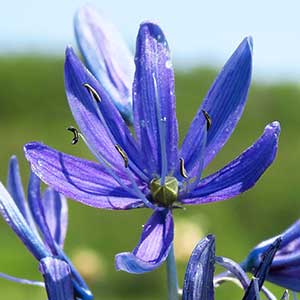Camassia quamash
Camassia cusickii
common camas
Cusick's camas
Leaves several, all basal, 8-20 mm. broad, considerably shorter than the scape.
Leaves are lance-linear, 30-50 cm long x 10-35 mm wide (but up to 50 mm wide) and typically number more than 10 per stem.
Flowering stems are 40-50 cm long and topped by a crowded inflorescence 50-80 cm long.
Inflorescence a raceme, many-flowered, 5-30 cm. long;
pedicels 10-20 mm. long, spreading, arched or ascending in flower, incurved-erect in fruit;
flowers pale to deep blue or violet, somewhat irregular;
tepals 6, distinct, 15-35 mm. long and 2-8 mm. broad, narrowed at base, lowest segment curved outward and downward away from the others, all withering separately and exposing the ovary;
stamens 6, anthers yellow or blue, style slender, stigmas 3.
Flowers are light blue and radially symmetrical or slightly irregular, with one of the six tepals diverging from the others. Tepals are 20-35 mm long x 3-5 mm wide with 3-5 veins and are not twisted above the fruit at maturity.
Capsule ovoid, 3-celled, 1-2.5 cm. long.
Fruit capsules are oval to elliptic, 15-25 mm long
The bulbs of Camassia cusickii are slimy, malodorous, and unpalatable.



